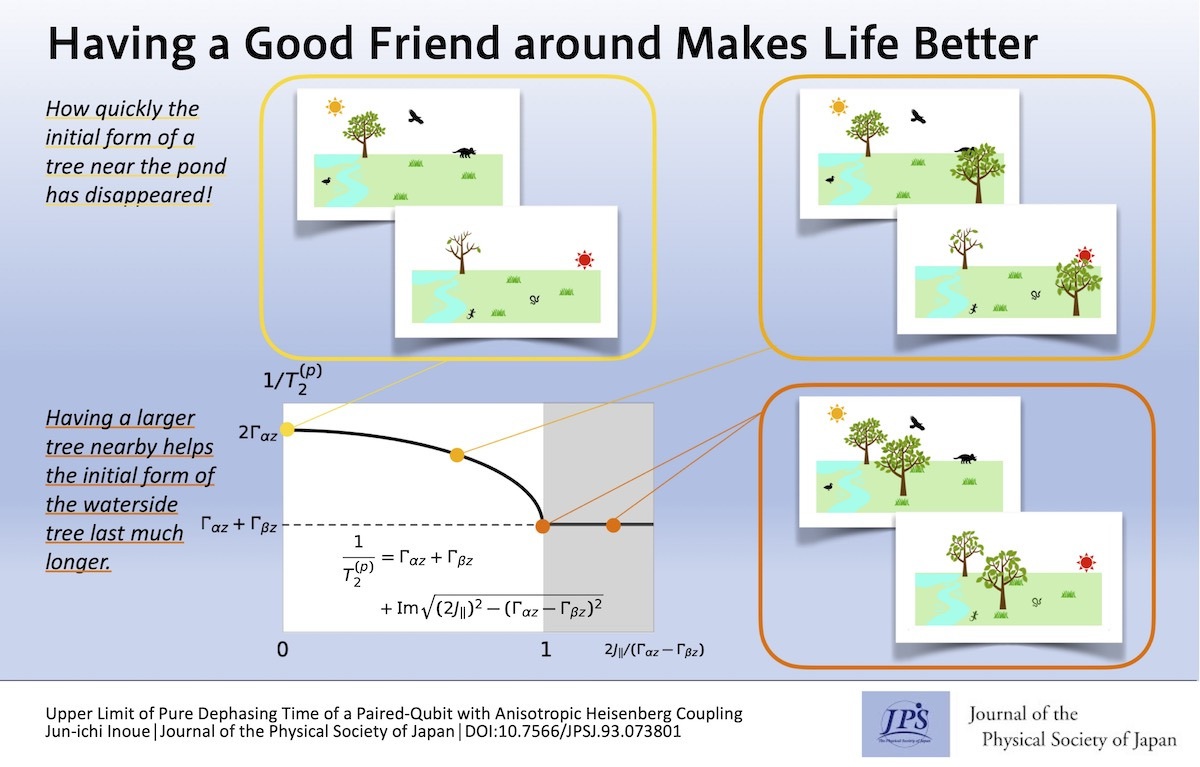Having a Good Friend around Makes Life Better
© The Physical Society of Japan
This article is on
Upper-Limit of Pure Dephasing Time of a Paired-Qubit with Anisotropic Heisenberg Coupling
J. Phys. Soc. Jpn. 93, 073801 (2024).
It is true that having a good friend around makes life better, and this idea is also true in the quantum world.

We are almost ready to roll out the application of qubits, which are two-state quantum-mechanical systems. Quantum computers are likely to be at the forefront, but sensors using quantum technology represent other platforms that are worthy of consideration. In this case, the best bet for qubits is to use point defects in diamonds, which are called negatively charged nitrogen-vacancy (NV-minus) centers. The qubit situated in the center is ideal in that it operates stably even at room temperature. This property is in stark contrast to that observed in superconductors.
Any quantum state is susceptible to a variety of noise sources, which ultimately result in the decay of the quantum state over time. A comprehensive study has demonstrated that the use of qubits with slow decay rates facilitates the attainment of a more refined sensing resolution. Therefore, one of the most important things to consider in a sensor is how long the quantum states can be maintained. Hence, a slow decay rate is a big plus.
As is easily expected, a short distance between a quantum sensor and a target to be measured is good for sensing. Therefore, having the sensor right next to the diamond surface would be advantageous. However, it's not that simple because surfaces have many of surface-specific sources that can accelerate the decay.
To address this trade-off, this article demonstrates that coupling with another qubit that has a slow decay rate improves the decay rate of a qubit near the diamond surface. For the case that anisotropic Heisenberg coupling between a qubit pair is assumed, the analytical result for the decay rate as a function of the coupling strength has been derived. The formula demonstrates which component of the interaction is the most dominant, and reveals that there is a limit to the potential for improvement in the decay rate.
This finding could be useful in quantum sensing technology, especially cases involving NV-minus centers in diamonds.
(Written by J.-i. Inoue.)
Upper-Limit of Pure Dephasing Time of a Paired-Qubit with Anisotropic Heisenberg Coupling
J. Phys. Soc. Jpn. 93, 073801 (2024).
Share this topic
Fields
Related Articles
-
Pressure-Tuned Classical–Quantum Crossover in Magnetic Field-Induced Quantum Phase Transitions of a Triangular-Lattice Antiferromagnet
Magnetic properties in condensed matter
Electron states in condensed matter
Cross-disciplinary physics and related areas of science and technology
2024-9-5
The correspondence principle states that as quantum numbers approach infinity, the nature of a system described by quantum mechanics should match that described by classical mechanics. Quantum phenomena, such as quantum superposition and quantum correlation, generally become unobservable when a system approaches this regime. Conversely, as quantum numbers decrease, classical descriptions give way to observable quantum effects. The external approach to classical–quantum crossover has attracted research interest. This study aims to demonstrate a method for achieving such control in materials.
-
Which is Moving?—Pinning Down the Origin of Fluctuations in Muon Spin Relaxation—
Structure and mechanical and thermal properties in condensed matter
Cross-disciplinary physics and related areas of science and technology
2024-3-28
The study demonstrated that we can distinguish between the diffusion motion of the muon itself and the motion of the surrounding ions in muon spin relaxation.
-
Thermodynamic Property of a CMOS Device beyond Landauer Limit
Statistical physics and thermodynamics
Electronic transport in condensed matter
Cross-disciplinary physics and related areas of science and technology
2024-1-23
Focusing on a CMOS NAND GATE operating in a sub-threshold region, the thermodynamic cost of computation was analyzed in relation to input/output voltages surpassing the Landauer limit.
-
Possible Origin of High Thermoelectric Power Factor in Ultrathin FeSe: A Two-band Model
Electronic structure and electrical properties of surfaces and nanostructures
Structure and mechanical and thermal properties in condensed matter
Cross-disciplinary physics and related areas of science and technology
2023-12-21
The high thermoelectric power factor observed in ultrathin FeSe can be theoretically explained by a two-band model with chemical potential between upper and lower band bottoms.
-
Exploring Recent Advances in the Physics of Biofluid Locomotion
Measurement, instrumentation, and techniques
Cross-disciplinary physics and related areas of science and technology
Electromagnetism, optics, acoustics, heat transfer, and classical and fluid mechanics
Statistical physics and thermodynamics
Mathematical methods, classical and quantum physics, relativity, gravitation, numerical simulation, computational modeling
Structure and mechanical and thermal properties in condensed matter
2023-12-8
This Special Topics Edition of the JPSJ describes the latest advances in the field of biofluid locomotion, shedding light on the underlying physics behind the movement of organisms that swim and fly.
